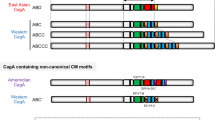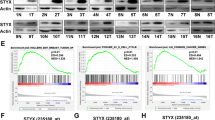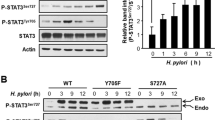Abstract
Helicobacter pylori induces a strong motogenic response in infected gastric epithelial host cells, which is enhanced by translocation of the pathogenic factor cytotoxin-associated gene A (CagA) into host cells via a specialized type IV secretion system. Once injected into the cytosol CagA is rapidly tyrosine phosphorylated by Src family kinases followed by Src inactivation. Hence, it remained unknown why CagA is constantly phosphorylated in sustained H. pylori infections to induce cell migration, whereas other substrates of Src kinases are dephosphorylated. Here, we identify the non-receptor tyrosine kinase c-Abl as a crucial mediator of H. pylori-induced migration and novel CagA kinase in epithelial cells. Upon H. pylori infection c-Abl directly interacts with CagA and localizes in focal adhesion complexes and membrane ruffles, which are highly dynamic cytoskeletal structures necessary for cell motility. Selective inhibition of c-Abl kinase activity by STI571 or shRNA abrogates sustained CagA phosphorylation and epithelial cell migration, indicating a pivotal role of c-Abl in H. pylori infection and pathogenicity. These results implicate c-Abl as a novel molecular target for therapeutic intervention in H. pylori-related gastric diseases.
This is a preview of subscription content, access via your institution
Access options
Subscribe to this journal
Receive 50 print issues and online access
$259.00 per year
only $5.18 per issue
Buy this article
- Purchase on Springer Link
- Instant access to full article PDF
Prices may be subject to local taxes which are calculated during checkout








Similar content being viewed by others
References
Al Ghoul L, Wessler S, Hundertmark T, Kruger S, Fischer W, Wunder C et al. (2004). Analysis of the type IV secretion system-dependent cell motility of Helicobacter pylori-infected epithelial cells. Biochem Biophys Res Commun 322: 860–866.
Amieva MR, Vogelmann R, Covacci A, Tompkins LS, Nelson WJ, Falkow S . (2003). Disruption of the epithelial apical-junctional complex by Helicobacter pylori CagA. Science 300: 1430–1434.
Argent RH, Zhang Y, Atherton JC . (2005). Simple method for determination of the number of Helicobacter pylori CagA variable-region EPIYA tyrosine phosphorylation motifs by PCR. J Clin Microbiol 43: 791–795.
Asahi M, Azuma T, Ito S, Ito Y, Suto H, Nagai Y et al. (2000). Helicobacter pylori CagA protein can be tyrosine phosphorylated in gastric epithelial cells. J Exp Med 191: 593–602.
Backert S, Moese S, Selbach M, Brinkmann V, Meyer TF . (2001). Phosphorylation of tyrosine 972 of the Helicobacter pylori CagA protein is essential for induction of a scattering phenotype in gastric epithelial cells. Mol Microbiol 42: 631–644.
Backert S, Ziska E, Brinkmann V, Zimny-Arndt U, Fauconnier A, Jungblut PR et al. (2000). Translocation of the Helicobacter pylori CagA protein in gastric epithelial cells by a type IV secretion apparatus. Cell Microbiol 2: 155–164.
Bagnoli F, Buti L, Tompkins L, Covacci A, Amieva MR . (2005). Helicobacter pylori CagA induces a transition from polarized to invasive phenotypes in MDCK cells. Proc Natl Acad Sci USA 102: 16339–16344.
Barila D, Rufini A, Condo I, Ventura N, Dorey K, Superti-Furga G et al. (2003). Caspase-dependent cleavage of c-Abl contributes to apoptosis. Mol Cell Biol 23: 2790–2799.
Bauer B, Moese S, Bartfeld S, Meyer TF, Selbach M . (2005). Analysis of cell type-specific responses mediated by the type IV secretion system of Helicobacter pylori. Infect Immun 73: 4643–4652.
Churin Y, Al Ghoul L, Kepp O, Meyer TF, Birchmeier W, Naumann M . (2003). Helicobacter pylori CagA protein targets the c-Met receptor and enhances the motogenic response. J Cell Biol 161: 249–255.
Corthesy-Theulaz I, Porta N, Pringault E, Racine L, Bogdanova A, Kraehenbuhl JP et al. (1996). Adhesion of Helicobacter pylori to polarized T84 human intestinal cell monolayers is pH dependent. Infect Immun 64: 3827–3832.
Echarri A, Pendergast AM . (2001). Activated c-Abl is degraded by the ubiquitin-dependent proteasome pathway. Curr Biol 11: 1759–1765.
Escalante M, Courtney J, Chin WG, Teng KK, Kim JI, Fajardo JE et al. (2000). Phosphorylation of c-Crk II on the negative regulatory Tyr222 mediates nerve growth factor-induced cell spreading and morphogenesis. J Biol Chem 275: 24787–24797.
Feller SM . (2001). Crk family adaptors-signalling complex formation and biological roles. Oncogene 20: 6348–6371.
Feller SM, Knudsen B, Hanafusa H . (1994a). c-Abl kinase regulates the protein binding activity of c-Crk. EMBO J 13: 2341–2351.
Feller SM, Ren R, Hanafusa H, Baltimore D . (1994b). SH2 and SH3 domains as molecular adhesives: the interactions of Crk and Abl. Trends Biochem Sci 19: 453–458.
Frasca F, Vigneri P, Vella V, Vigneri R, Wang JY . (2001). Tyrosine kinase inhibitor STI571 enhances thyroid cancer cell motile response to hepatocyte growth factor. Oncogene 20: 3845–3856.
Hantschel O, Superti-Furga G . (2004). Regulation of the c-Abl and Bcr-Abl tyrosine kinases. Nat Rev Mol Cell Biol 5: 33–44.
Hatakeyama M . (2004). Oncogenic mechanisms of the Helicobacter pylori CagA protein. Nat Rev Cancer 4: 688–694.
Hernandez SE, Krishnaswami M, Miller AL, Koleske AJ . (2004). How do Abl family kinases regulate cell shape and movement? Trends Cell Biol 14: 36–44.
Higashi H, Tsutsumi R, Muto S, Sugiyama T, Azuma T, Asaka M et al. (2002). SHP-2 tyrosine phosphatase as an intracellular target of Helicobacter pylori CagA protein. Science 295: 683–686.
Ito Y, Pandey P, Mishra N, Kumar S, Narula N, Kharbanda S et al. (2001). Targeting of the c-Abl tyrosine kinase to mitochondria in endoplasmic reticulum stress-induced apoptosis. Mol Cell Biol 21: 6233–6242.
Kain KH, Klemke RL . (2001). Inhibition of cell migration by Abl family tyrosine kinases through uncoupling of Crk–CAS complexes. J Biol Chem 276: 16185–16192.
Lewis JM, Schwartz MA . (1998). Integrins regulate the association and phosphorylation of paxillin by c-Abl. J Biol Chem 273: 14225–14230.
Machuy N, Rajalingam K, Rudel T . (2004). Requirement of caspase-mediated cleavage of c-Abl during stress-induced apoptosis. Cell Death Differ 11: 290–300.
Mayer BJ, Hirai H, Sakai R . (1995). Evidence that SH2 domains promote processive phosphorylation by protein-tyrosine kinases. Curr Biol 5: 296–305.
Mimuro H, Suzuki T, Tanaka J, Asahi M, Haas R, Sasakawa C . (2002). Grb2 is a key mediator of helicobacter pylori CagA protein activities. Mol Cell 10: 745–755.
Moese S, Selbach M, Kwok T, Brinkmann V, Konig W, Meyer TF et al. (2004). Helicobacter pylori induces AGS cell motility and elongation via independent signaling pathways. Infect Immun 72: 3646–3649.
Odenbreit S, Puls J, Sedlmaier B, Gerland E, Fischer W, Haas R . (2000). Translocation of Helicobacter pylori CagA into gastric epithelial cells by type IV secretion. Science 287: 1497–1500.
Plattner R, Kadlec L, DeMali KA, Kazlauskas A, Pendergast AM . (1999). c-Abl is activated by growth factors and Src family kinases and has a role in the cellular response to PDGF. Genes Dev 13: 2400–2411.
Schmitt W, Haas R . (1994). Genetic analysis of the Helicobacter pylori vacuolating cytotoxin: structural similarities with the IgA protease type of exported protein. Mol Microbiol 12: 307–319.
Segal ED, Cha J, Lo J, Falkow S, Tompkins LS . (1999). Altered states: involvement of phosphorylated CagA in the induction of host cellular growth changes by Helicobacter pylori. Proc Natl Acad Sci USA 96: 14559–14564.
Selbach M, Moese S, Backert S, Jungblut PR, Meyer TF . (2004). The Helicobacter pylori CagA protein induces tyrosine dephosphorylation of ezrin. Proteomics 4: 2961–2968.
Selbach M, Moese S, Hauck CR, Meyer TF, Backert S . (2002). Src is the kinase of the Helicobacter pylori CagA protein in vitro and in vivo. J Biol Chem 277: 6775–6778.
Selbach M, Moese S, Hurwitz R, Hauck CR, Meyer TF, Backert S . (2003). The Helicobacter pylori CagA protein induces cortactin dephosphorylation and actin rearrangement by c-Src inactivation. EMBO J 22: 515–528.
Srinivasan D, Plattner R . (2006). Activation of Abl tyrosine kinases promotes invasion of aggressive breast cancer cells. Cancer Res 66: 5648–5655.
Stein M, Bagnoli F, Halenbeck R, Rappuoli R, Fantl WJ, Covacci A . (2002). c-Src/Lyn kinases activate Helicobacter pylori CagA through tyrosine phosphorylation of the EPIYA motifs. Mol Microbiol 43: 971–980.
Stein M, Rappuoli R, Covacci A . (2000). Tyrosine phosphorylation of the Helicobacter pylori CagA antigen after cag-driven host cell translocation. Proc Natl Acad Sci USA 97: 1263–1268.
Suzuki M, Mimuro H, Suzuki T, Park M, Yamamoto T, Sasakawa C . (2005). Interaction of CagA with Crk plays an important role in Helicobacter pylori-induced loss of gastric epithelial cell adhesion. J Exp Med 202: 1235–1247.
Tomb JF, White O, Kerlavage AR, Clayton RA, Sutton GG, Fleischmann RD et al. (1997). The complete genome sequence of the gastric pathogen Helicobacter pylori. Nature 388: 539–547.
Van Etten RA . (2003). c-Abl regulation: a tail of two lipids. Curr Biol 13: R608–R610.
Viala J, Chaput C, Boneca IG, Cardona A, Girardin SE, Moran AP et al. (2004). Nod1 responds to peptidoglycan delivered by the Helicobacter pylori cag pathogenicity island. Nat Immunol 5: 1166–1174.
Wessler S, Hocker M, Fischer W, Wang TC, Rosewicz S, Haas R et al. (2000). Helicobacter pylori activates the histidine decarboxylase promoter through a mitogen-activated protein kinase pathway independent of pathogenicity island-encoded virulence factors. J Biol Chem 275: 3629–3636.
WHO. (1994). Schistosomes, liver flukes and Helicobacter pylori. IARC Working Group on the Evaluation of Carcinogenic Risks to Humans. Lyon, 7-14 June 1994. IARC Monogr Eval Carcinog Risks Hum 61: 1–241.
Woodring PJ, Litwack ED, O'Leary DD, Lucero GR, Wang JY, Hunter T . (2002). Modulation of the F-actin cytoskeleton by c-Abl tyrosine kinase in cell spreading and neurite extension. J Cell Biol 156: 879–892.
Yuan ZM, Shioya H, Ishiko T, Sun X, Gu J, Huang YY et al. (1999). p73 is regulated by tyrosine kinase c-Abl in the apoptotic response to DNA damage. Nature 399: 814–817.
Acknowledgements
We thank Novartis for providing STI571, Philippe Soriano for SYF and SYF + Src cells and Steffen Backert for discussing unpublished results.
Author information
Authors and Affiliations
Corresponding author
Rights and permissions
About this article
Cite this article
Poppe, M., Feller, S., Römer, G. et al. Phosphorylation of Helicobacter pylori CagA by c-Abl leads to cell motility. Oncogene 26, 3462–3472 (2007). https://doi.org/10.1038/sj.onc.1210139
Received:
Revised:
Accepted:
Published:
Issue Date:
DOI: https://doi.org/10.1038/sj.onc.1210139
Keywords
This article is cited by
-
Helicobacter pylori: an up-to-date overview on the virulence and pathogenesis mechanisms
Brazilian Journal of Microbiology (2022)
-
Molecular anatomy and pathogenic actions of Helicobacter pylori CagA that underpin gastric carcinogenesis
Cellular & Molecular Immunology (2020)
-
Rational design of small molecule RHOA inhibitors for gastric cancer
The Pharmacogenomics Journal (2020)
-
Helicobacter pylori-controlled c-Abl localization promotes cell migration and limits apoptosis
Cell Communication and Signaling (2019)
-
From inflammation to gastric cancer – the importance of Hedgehog/GLI signaling in Helicobacter pylori-induced chronic inflammatory and neoplastic diseases
Cell Communication and Signaling (2017)



